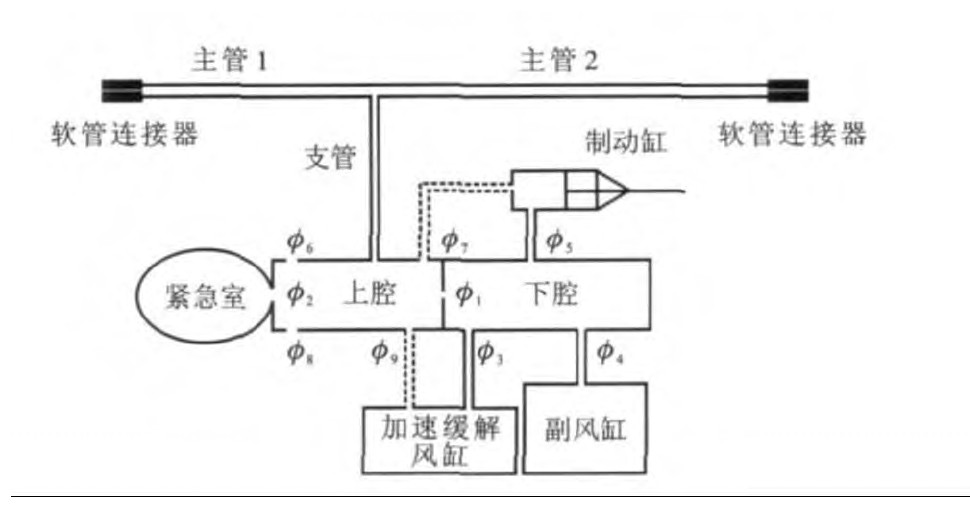Influence of braking pipe on braking performance for heavy haul train
Article Text (Baidu Translation)
-
摘要: 应用流体动力学理论, 建立了重载列车制动管路模型与分配阀模型, 求解了制动管路和边界点的动力学方程, 仿真计算了制动过程中的制动系统性能, 分析了列车主管和支管长度对制动系统性能的影响。分析结果表明: 当列车主管长度由13.24 m增大为17.24 m时, 在常用制动下, 列车管路减压时间增大了30.75%, 制动缸升压时间增大了20.45%, 主管长度对常用制动的影响要强于对紧急制动的影响; 当列车支管长度由0.50 m增大到5.00 m时, 在常用制动下, 列车管路减压时间增大了6.63%, 制动缸升压时间增大了5.22%, 支管长度对常用制动和紧急制动影响程度差别不大。列车制动管路长度增大降低了列车制动管路减压速度与制动缸升压速度; 列车主管长度对制动性能的影响要明显大于列车支管长度的影响, 车辆位置距机车越远影响越明显。Abstract: With fluid dynamics theory, the models of braking pipe and distributing valve for heavy haul train were built, the equations of braking pipe and boundary point were solved, the braking system performances in braking process were simulated, and the influence of the lengths of main pipe and branch pipe on the braking performances was analyzed.Analysis result shows that under common braking, when the length of main pipe increases from 13.24 m to 17.24 m, the decompression time of braking pipe increases by 30.75%, and the boost time of braking cylinder increases by 20.45%.The influence of main pipe on common braking is even stronger than that of main pipe on emergency braking.Under common braking, when the length of branch pipe increases from 0.50 m to 5.00 m, the decompression time of braking pipe increases by 6.63%, and the boost time of braking cylinder increases by 5.22%.The influence of branch pipe on common braking is almost same for that of branch pipe on emergency braking.The increase length of braking pipe reduces the decompression speed of braking pipe and the boost speed of braking cylinder.The influence of the length of main pipe is stronger than that of branch pipe, and the influence becomes obviously with the increase of the distance between car and locomotive.
-
Key words:
- heavy haul train /
- braking system /
- air braking /
- braking pipe /
- main pipe /
- branch pipe /
- air flow /
- braking performance /
- simulation
-
-
[1] PIECHOWIAK T. Pneumatic train brake simulation method[J]. Vehicle System Dynamics, 2009, 47(12): 1-20. [2] PIECHOWI AK T. Verification of pneumatic rail way brake model[J]. Vehicle System Dynamics. 2010, 48(3): 283-299. [3] PUGI L, PALAZZOLO A, FIORAVANTI D. Simulation of rail way brake plants: an application to SAADKMS freight wagons[J]. Proceeding of the Institution of Mechanical Engineers, Part F: Journal of Rail and Rapid Transit, 2008, 222(4): 321-329. doi: 10.1243/09544097JRRT118 [4] PUGI L, MALVEZZI M, ALLOTTAB, et al. A parametric library for the simulation of a Union Internationale des Chemins de Fer (UIC) pneumatic braking system[J]. Proceeding of the Institution of Mechanical Engineers, Part F: Journal of Rail and Rapid Transit, 2004, 218(2): 117-132. doi: 10.1243/0954409041319632 [5] CANTONE L, CRESCENTI NI E, VERZICCOL R, et al, Anumerical model for the analysis of unsteady train braking and releasing manoeuvres[J]. Proceedings of the Institution of Mechanical Engineers, Part F: Journal of Rail and Rapid Transit, 2009, 223(3): 305-317. doi: 10.1243/09544097JRRT240 [6] CANTONE L. Train Dy: the new Union Internationale des Chemins de Fer software for freight train inter operability[J]. Proceeding of the Institution of Mechanical Engineers, Part F: Journal of Rail and Rapid Transit, 2011, 225(1): 57-70. doi: 10.1243/09544097JRRT347 [7] NAMS W, KIM HJ. A study on the improvement of release application characteristics of pneumatic brakes for freight train[J]. Journal of Mechanical Science and Technology, 2002, 16(6): 776-784. [8] 魏伟, 张善荣, 刘庆忠. 长大列车制动系统减压特性的计算机模拟[J]. 大连铁道学报, 1992, 13(4): 43-49. https://www.cnki.com.cn/Article/CJFDTOTAL-DLTD199204007.htmWEI Wei, ZHANG Shan-rong, LIU Qing-zhong. A study on characteristic of pressure reduction of air brake system in a long train[J]. Journal of Dalian Rail way Institute, 1992, 13(4): 43-49. (in Chinese) https://www.cnki.com.cn/Article/CJFDTOTAL-DLTD199204007.htm [9] 魏伟, 李文辉. 列车空气制动系统数值仿真[J]. 铁道学报, 2003, 25(1): 38-42. https://www.cnki.com.cn/Article/CJFDTOTAL-TDXB200301008.htmWEI Wei, LI Wen-hui. Simulation model of train brake system[J]. Journal of the China Rail way Society, 2003, 25(1): 38-42. (in Chinese) https://www.cnki.com.cn/Article/CJFDTOTAL-TDXB200301008.htm [10] WEI Wei, LIN Ye. Simulation of a freight train brake system with 120 valves[J]. Proceeding of the Institution of Mechanical Engineers, Part F: Journal of Rail and Rapid Transit, 2009, 223(1): 85-92. doi: 10.1243/09544097JRRT119 [11] 魏伟. 列车空气制动系统仿真的有效性[J]. 中国铁道科学, 2006, 27(5): 105-109. https://www.cnki.com.cn/Article/CJFDTOTAL-ZGTK200605019.htmWEI Wei. The validity of the simulation for train air brake system[J]. China Rail way Science, 2006, 27(5): 105-109. (in Chinese) https://www.cnki.com.cn/Article/CJFDTOTAL-ZGTK200605019.htm [12] 魏伟, 刘涛, 张军. KZ1型控制阀仿真模型及列车制动性能仿真研究[J]. 中国铁道科学, 2010, 31(1): 105-110 https://www.cnki.com.cn/Article/CJFDTOTAL-ZGTK201001021.htmWEI Wei, LIU Tao, ZHANG Jun. The simulation model of KZ1 control valve and the simulation study on train braking performance[J]. China Rail way Science, 2010, 31(1): 105-110. (in Chinese) https://www.cnki.com.cn/Article/CJFDTOTAL-ZGTK201001021.htm [13] 魏伟. 120阀及试验台的计算机模拟[J]. 铁道学报, 2000, 22(1): 31-35. https://www.cnki.com.cn/Article/CJFDTOTAL-TDXB200001006.htmWEI Wei. Computer simulation of 120 vehicle distributing valve and its testrig[J]. Journal of the China Rail way Society, 2000, 22(1): 31-35. (in Chinese) https://www.cnki.com.cn/Article/CJFDTOTAL-TDXB200001006.htm [14] 魏伟, 赵连刚. 两万吨列车纵向动力学性能预测[J]. 大连交通大学学报, 2009, 30(2): 39-43. https://www.cnki.com.cn/Article/CJFDTOTAL-DLTD200902010.htmWEI Wei, ZHAO Lian-gang. Prediction of longitudinal dynamic coupler force of 20 000 ton connected train[J]. Journal of Dalian Jiaotong University, 2009, 30(2): 39-43. (in Chinese) https://www.cnki.com.cn/Article/CJFDTOTAL-DLTD200902010.htm [15] 魏伟, 项宇航. 机车风源系统设计方法研究[J]. 大连交通大学学报, 2010, 31(5): 1-5. https://www.cnki.com.cn/Article/CJFDTOTAL-DLTD201005001.htmWEI Wei, XIANG Yu-hang. Study of air supply system design for locomotive[J]. Journal of Dalian Jiaotong University, 2010, 31(5): 1-5. (in Chinese) https://www.cnki.com.cn/Article/CJFDTOTAL-DLTD201005001.htm [16] 魏伟, 于忠建. 从控机车滞后时间对3万t列车纵向力的影响[J]. 交通运输工程学报, 2011, 11(2): 39-44. http://transport.chd.edu.cn/article/id/201102007WEI Wei, YU Zhong-jian. Influence of lag time for slave control loco motive on longitudinal coupler forces of 30 000 t train[J]. Journal of Traffic and Transportation Engineering, 2011, 11(2): 39-44. (in Chinese) http://transport.chd.edu.cn/article/id/201102007 [17] 刘金朝, SEONG W, 王成国, 等. 长大货物列车空气管系3维充气模型的数值仿真[J]. 中国铁道科学, 2005, 26(5): 66-71. https://www.cnki.com.cn/Article/CJFDTOTAL-ZGTK200505014.htmLIU Jin-zhao, SEONG W, WANG Cheng-guo, et al. Numerical simulation of 3D air charging model of the heavy haul train air brake pipes system[J]. China Rail way Science, 2005, 26(5): 66-71. (in Chinese) https://www.cnki.com.cn/Article/CJFDTOTAL-ZGTK200505014.htm -





 下载:
下载:











